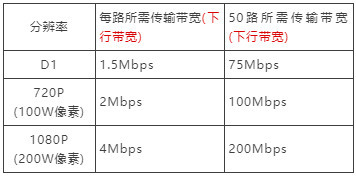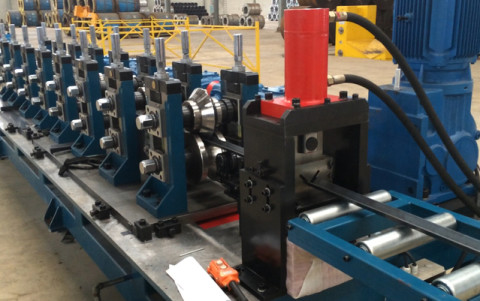In the video surveillance system, the transmission bandwidth of the video file is very important. How is the transmission bandwidth of the video file calculated? First introduce a few nouns to everyone.
(1) Bit rate
The bit rate is the number of bits transmitted per second. The unit is bps (BitPerSecond). The higher the bit rate, the larger the data transmitted. The bit rate indicates how many bits are needed per second for the encoded (compressed) audio and video data, and the bit is the smallest unit in the binary, either 0 or 1. The relationship between bit rate and audio and video compression is simply that the higher the bit rate, the better the quality of the audio and video, but the larger the encoded file; if the bit rate is smaller, the situation is just the opposite.
(2) code stream
The data stream (DataRate) refers to the data traffic used by the video file in unit time, also called the code rate, which is the most important part of the picture quality control in video coding. At the same resolution, the larger the code stream of the video file, the smaller the compression ratio and the higher the picture quality.
(3) Upstream bandwidth
The upstream bandwidth is the bandwidth of the locally uploaded information to the network. The uplink rate refers to the data transmission rate when the user computer sends information to the network. For example, uploading files to the Internet using FTP, the upload speed is the "uplink rate".
(4) Downstream bandwidth
Downstream bandwidth is the bandwidth from which information is downloaded from the network. The downlink rate refers to the data transmission rate when the user computer downloads information from the network. For example, the file is downloaded from the FTP server to the user's computer, and the downlink speed is the "downlink rate".
Transmission bandwidth calculation:
Bit rate size × number of cameras = at least the size of the network bandwidth
The bandwidth of the monitoring point is the minimum bandwidth required for the uplink (the monitoring point uploads the video information to the monitoring center); the bandwidth of the monitoring center is the minimum bandwidth required to download the downlink (download the video information of the monitoring point to the monitoring center); 2Mbps ADSL broadband, in theory, its upstream bandwidth is 512Kbps = 64KB / s, and its downstream bandwidth is 2Mbps = 256KB / s.
Example: Monitoring is distributed in 5 different places, the number of cameras in each place: n=10, 1 monitoring center, remote monitoring and storage of video information, the bandwidth of different video formats is calculated as follows:
(1) Local monitoring points
Upstream bandwidth = bit rate of video format × number of cameras

That is: theoretically, the network uplink bandwidth required for monitoring in various places of the D1 video format is at least 15 Mbps; the 720P is at least 20 Mbps; and the 1080P is at least 40 Mbps.
(2) Monitoring Center
Downstream bandwidth = bit rate of video format × sum of total number of cameras of monitoring points

That is: theoretically, the network downlink bandwidth required by the D1 video format monitoring center is at least 75 Mbps, 720P is at least 100 Mbps, and 1080P is at least 200 Mbps. It should be noted that according to the current network bandwidth utilization rate on the market, about 80% is basically the limit.
For example, the mobile phone remote access device, open a channel, 720P resolution, code stream value of 2048kbps, both upstream and downstream bandwidth need 2Mbps, then the ADSL broadband bandwidth needs at least 8Mbps while keeping the picture smooth. When trying to open multiple images at the same time, it may appear to be stuck or unable to open. It is recommended to use the secondary stream to access. In the same environment, the bandwidth occupied by the secondary code stream is small, and can be adjusted in the coding setting of the device.
Network camera common troubleshooting method
1. Infrared HD network camera is normal during the day, no signal at night
Cause: The power supply is insufficient. Since the infrared light is turned on at night, the infrared light will consume a certain amount of current. If the power quality is not good, the power supply will be insufficient, resulting in the HD network camera not starting normally.
Solution: Replace some power supplies
2, HD network camera uncertainty often dropped
Reason 1: The centralized power supply mode is adopted. The requirements of the high-definition network camera for the power adapter are relatively higher than those of the simulator, and a relatively stable voltage and current are required. However, due to the unstable voltage and current caused by the centralized power supply, all of the HD will be caused. The network camera can't be restarted or started.
Solution: Change to separate power supply mode, use better power supply
Cause 2: The quality of the network cable is poor. The requirements for high-definition video on the network transmission rate are relatively high. Therefore, the network packet loss will be very obvious. For example, the cable is often dropped, and the image is not displayed at all.
Solution: use the national standard pure copper cable
Cause 3: The network cable distance between the HD network camera and the switch/or between the switch and the switch/or between the switch and the PC/NVR is more than 100 meters.
Solution: You can add a switch with relay function in the middle no more than 100 meters, or use fiber transmission.
Cause 4: The IP address of the HD network camera and other network devices in the LAN conflict.
Solution: Modify the IP address of the HD network camera or other network devices to ensure no conflicts.
Cause 5: The bandwidth of the network switch is insufficient.
Solution: If the number of HD network cameras is higher, it is recommended to use H3C full Gigabit switches. However, it should be noted that not only the central switch adopts Gigabit, but also the front-end switch recommends Gigabit if the number of cameras involved exceeds seven.
Racking Roll Forming Machine is a kind of equipment mainly for making rack for supporting supermarket shelf, Storage Rack, Ware House Rack and others.The Racking Roll Forming Machine have other name: storage rack roll formign machine, it adopts track cutting technology to ensure the machine capactiy and gear box transmission and ensure the machine's rigidity and working strength.This Racking Roll Forming Machine adopts servo controlled material feeding technology for complex punching to guarantee precision.Except them,we also provid Dust Shield Forming Machine,Pallet Rack Roll Forming Machine,Unistrut Forming Machine.


Racking Roll Forming Machine
Racking Roll Forming Machine,Storage Rack Roll Forming Machine,Racking Frame Roll Forming Machine,Dust Shield Forming Machine,Pallet Rack Roll Forming Machine,Unistrut Forming Machine
Zhongtuo Roll Forming Machinery Co., ltd , https://www.rollsformingmachines.com



